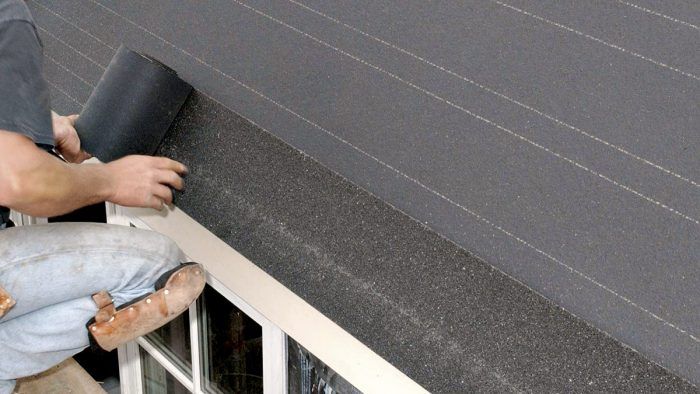The Starter Course
Use either a trimmed three-tab shingle or a rolled starter strip for the first course along the eaves; you'll cover it with the first row of shingles.

After attaching drip-edge to the eaves of a roof and rolling out underlayment over the drip-edge, it’s time to install the starter course along the eaves. You’ll cover the starter course with the first course of shingles. Running starter courses along the rakes isn’t imperative, but it’s smart because starters stiffen the overhanging shingle edges and create a cleaner sightline from below.
First, determine how much the starter course will overhang the drip-edge: 1⁄4 in. to 3⁄4 in. overhang is typical, but some roofers allow as much as 1 in. if eave or rake boards are bowed.
Along the eave, extend your tape measure past the drip-edge the amount of the overhang. If that overhang is 1 in., make crayon marks on the underlayment at 7 in. and at 12 in. Do this at both ends of the roof, and snap chalklines through both sets of marks. The 7-in. line indicates the top of the starter course; the 12-in. line indicates the top of the first course of shingles.
Starter courses can be three-tab shingles with the bottom 5 in. cut off or a starter strip that comes on rolls in various widths. Starter strips have the advantage of stiffening shingles above and, viewed from below, providing a clean, unbroken line. Still, trimming three-tab shingles is cheaper, so here’s a quick look at that method.
Traditionally, the starter course was just a full shingle turned upside down so its tabs faced up, but that placed the shingle’s self-seal strip too high to do much good. It’s far better to measure down 7 in. from the top of the shingle, trim off the bottom 5 in., and snap off the shingle tabs.
Align the top edge of the starter shingles to the 7-in. control line and nail them down, four nails per shingle. If you’re installing a starter strip, align its top edge to the 7-in. control line. Next, install starter courses over rake drip-edges, using the same overhang you used for eaves. Rake starter strips overlap eave starter courses when they meet at lower corners. Along both ends of the roof, measure up from the 12-in. control line and snap horizontal chalklines for the shingle courses to come. As noted earlier, a horizontal chalkline every two or three shingle courses is plenty. Once that’s done, you’re ready to install the first course of shingles.
One final note: Building-paper underlayment tears pretty easily if it gets too much traffic, so only roll out one strip of building paper at a time. Install shingle courses until you are close to the upper edge of the felt paper, then roll out the next strip so that its lower edge overlaps the one below. This isn’t a concern if you choose to use a synthetic roofing underlayment.
Fine Homebuilding Recommended Products
Fine Homebuilding receives a commission for items purchased through links on this site, including Amazon Associates and other affiliate advertising programs.

Reliable Crimp Connectors

Affordable IR Camera

8067 All-Weather Flashing Tape







